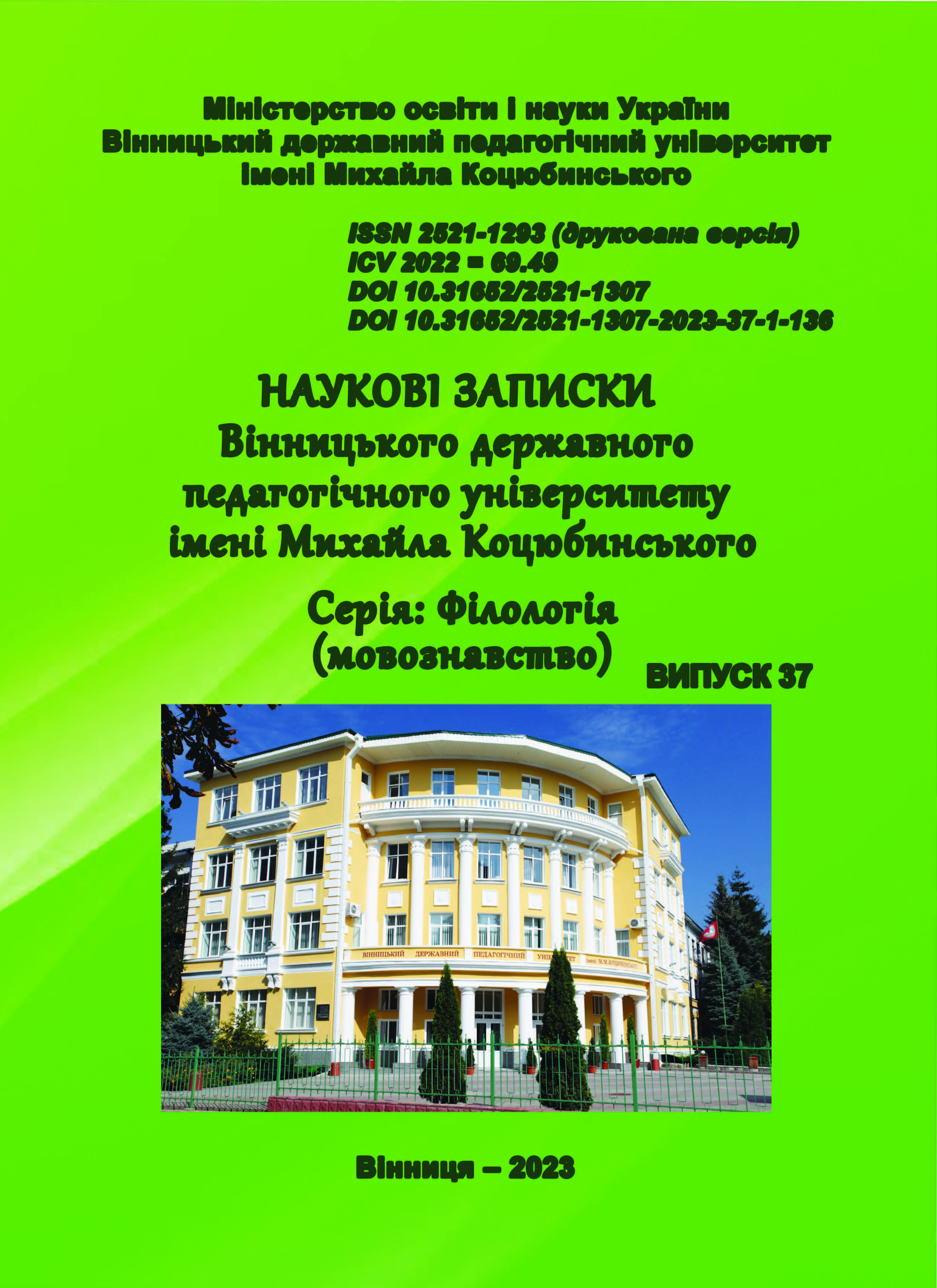Verbalization of imperative modalityin prose works for children: semantics and pragmatics
https://doi.org/10.31652/2521-1307-2023-37-100-110Published 2023-12-20
Keywords
- sentence, semantic-syntactic structure of a sentence, imperative modality, specialized means of expressing imperative modality, non-specialized means of expressing imperative modality, modifier, communicative situation, language competence, prose language for children
Copyright (c) 2023 Світлана Харченко

This work is licensed under a Creative Commons Attribution 4.0 International License.
How to Cite
Abstract
Introduction. Children's literature is a special type of literature that combines aesthetic, didactic, and educational functions. The language of works for children is as closely related as possible to the implementation of these functions, which are aimed at the formation of a complete, independent, empathic personality. Imperative sentences play an important role at all stages of the development of a child's language competence.
Purpose. The article aims to investigate the peculiarities of the verbalization of the imperative modality in prose for children, to determine which (non)specialized syntactic means for expressing the imperative modality are emphasized in prose works for children, the conditions of their actualization, which modifiers of the semantic-syntactic structure are used.
Methods. Descriptive and interpretive methods were used to achieve the goal, and partly quantitative methods were used.
Results. The Ukrainian language has developed a set of specialized and non-specialized means of verbalizing the imperative modality. The current importance of this or that syntactic means of verbalization of motivational modality in prose language for children depends on the age of the child. The most used one in the language of prose for children is the semantic-syntactic structure with a verbal predicate expressed in the imperative form. Prose works for children also use imperative nominative, vocative sentences and imperative sentences with a non-verbalized predicate of the adverbial and object type, but numerically, their use is infrequent. Besides, the use of simple imperative sentences with homogeneous members and the use of composite imperative sentences are also infrequent. Sporadic use of complex sentences or with different types of linking help to gradually develop the child's cognitive and evaluative abilities. Personal pronominal noun, modifiers (filler words, particles, addressing personally, exclamations) in imperative sentences strengthen / weaken its variant meaning, add additional shades of meaning to the main meaning of the statement or a separate component. The results of the research will be useful for editors of prose works for preschoolers and children of primary school age.
Conclusion. In the language of prose for children, only specialized means of verbalization of the imperative modality are used, among which the semantic-syntactic structure with a verbalized predicate expressed in the imperative form is the most used. Imperative nominative, vocative sentences and imperative sentences with non-verbalized predicate of adverbial and object type, simple imperative sentences with homogeneous members, composite imperative sentences are sporadically used. We see the prospects for further scientific research in the following: to investigate the verbalization of the imperative modality on a wider empirical material, to trace the dynamics of the actualization of specialized and non-specialized means of verbalization of the imperative modality in prose works for children of different ages and in spontaneous children's speech, to propose a classification of children's expressions of the imperative modality.
Downloads
References
- Атрошенко Г.І. Лінгвостилістика української поезії для дітей: дис … кандидата філол. наук: 10.02.01. Запоріжжя, 2005. 209 с.
- Голіченко М. О. Комунікативно-прагматичні функції вокативних речень в українському художньому та політичному дискурсах : дис. … кандидата філол. наук : 10.02.01. Київ, 2018. 212 с.
- Гоменюк О. До проблеми лінгвістичного вивчення текстів дитячої літератури // Дискурс у сучасному науковому, соціокультурному та інформаційному просторі: збірник тез доповідей Міжнародної науково-практичної конференції «Дискурс у сучасному науковому, соціокультурному та інформаційному просторі». 24-25 травня 2013 року. / За заг. ред. професора І. В. Соколової. Маріуполь: МДУ, 2013. С. 37‒39.
- Кондратенко Н. В. Синтаксис українського модерністського і постмодерністського художнього дискурсу. Київ, 2012. 324 с.
- Нестайко В. З. Дивовижні пригоди в лісовій школі. Сонце серед ночі. Пригоди в Павутинії. Київ: ВД «Школа», 2022. 208 с.
- Нестайко В. З. Чарівні окуляри: Правдиво-фантаст. повість про надзвичайні пригоди київських школярів: Для мол. і серед. шк. віку / Худож. А. Василенко. 2-ге вид. Київ: Веселка; Тернопіль: Навч. кн. – Богдан, 2008. 95 с.
- Нестайко В. З. Чародій Будьласка і чаклун Нетреба : Казкові пригоди Грайлика. Пригода п’ята : Казкова повість : нова авт. ред. / Худож. О. Чичик. Київ: Компанія ОСМА, 2015. 64 с.
- Огар Е. І. Мова дитячого літературного дискурсу: функціонально-комунікативні аспекти дослідження. Вісн. Сум. держ. ун-ту. Сер. Філол. науки. 2006. № 3. С. 10‒17.
- Сологуб Н. М. Синтаксис художньої літератури для дітей // Твори для дітей і про дітей у вітчизняній і зарубіжній літературі : матеріали доповідей обласної міжвузівської науково-методичної конференції (11–15 травня 1991 р.). Ч. 1. Одеса, 1991. С. 63–65.
- Харченко С. Засоби вираження спонукання в українській літературній мові: семантико- синтаксичний і комунікативний аспекти : монографія. Київ: Міленіум, 2015. 210 с.





